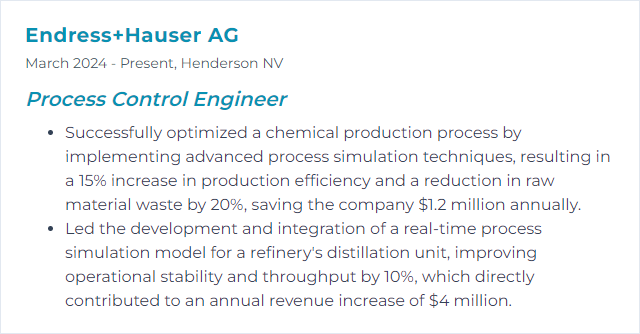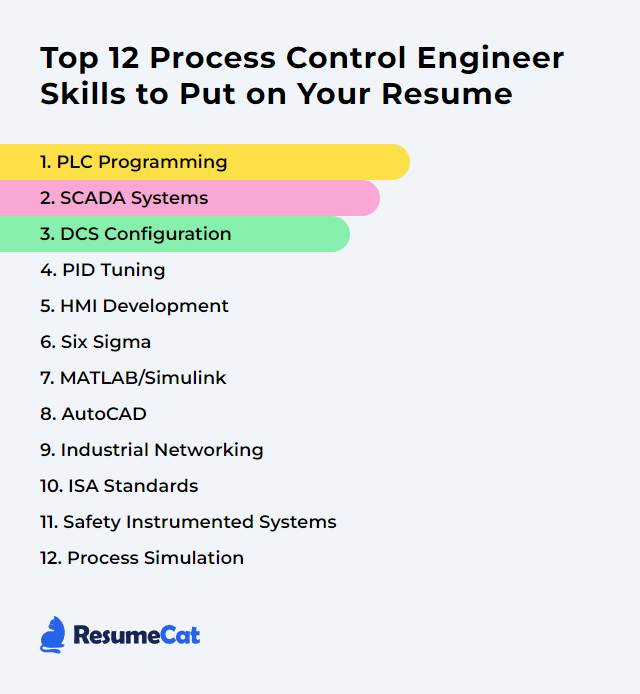Top 12 Process Control Engineer Skills to Put on Your Resume
Process control engineering lives in the trenches where uptime, safety, and yield actually get decided. Showcase the right skills and a resume starts humming—precise, grounded, and hard to ignore. Below you’ll find twelve capabilities that hiring managers keep scanning for, tightened up for today’s tools, standards, and expectations.
Process Control Engineer Skills
- PLC Programming
- SCADA Systems
- DCS Configuration
- PID Tuning
- HMI Development
- Six Sigma
- MATLAB/Simulink
- AutoCAD
- Industrial Networking
- ISA Standards
- Safety Instrumented Systems
- Process Simulation
1. PLC Programming
PLC programming means crafting logic for industrial controllers to run machines and processes with consistency and speed. IEC 61131-3 languages (Ladder, Structured Text, Function Block, SFC) form the backbone; the rest is architecture, discipline, and solid testing.
Why It's Important
It’s the hands on the levers of automation. Faster startups, safer plants, fewer nasty surprises. Good PLC logic keeps product moving and alarms quiet.
How to Improve PLC Programming Skills
Go deep on the languages and go broad on ecosystems: Studio 5000 Logix Designer, Siemens TIA Portal, Beckhoff TwinCAT 3, CODESYS. Use emulation and simulation (e.g., virtual controllers, PLCSIM, TwinCAT simulation) to try edge cases before they touch steel. Standardize naming, UDTs/AOIs, and reusable modules. Version control everything. Build diagnostics and safe states into the logic. Learn safety PLC concepts and interlocks. Document I/O, add comments with intent, and tune for scan performance. Treat cybersecurity as part of design (unique creds, least privilege, hardening).
How to Display PLC Programming Skills on Your Resume
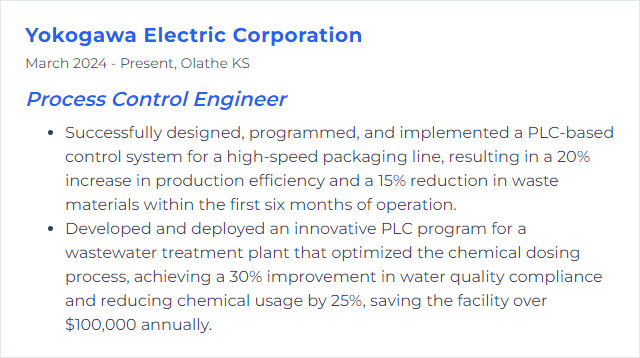
2. SCADA Systems
SCADA stitches sensors, controllers, and operators together—collecting data, visualizing states, commanding setpoints, and archiving history so the plant can be steered with facts, not guesses.
Why It's Important
Real-time monitoring, clean alarming, and trustworthy history drive stable operations and smart decisions. When SCADA falters, downtime sneaks in.
How to Improve SCADA Systems Skills
Harden and maintain: patch servers, apply least privilege, isolate OT with a DMZ, and monitor remote access. Build redundancy for servers, comms, and historians; rehearse disaster recovery. Rationalize alarms per ISA 18.2 so operators see the vital few. Use secure protocols (OPC UA, MQTT with security) and time-sync the fleet (NTP/PTP). Design responsive screens and efficient queries to keep latency low. Tie analytics to historians for KPIs and predictive triggers. Train operators regularly; validate changes in a staging environment first.
How to Display SCADA Systems Skills on Your Resume
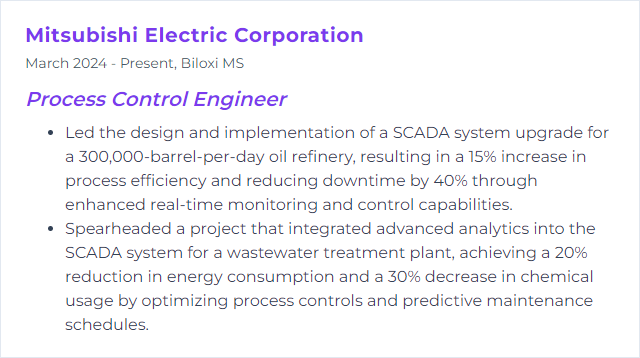
3. DCS Configuration
DCS configuration sets the plant’s nervous system: control strategies, graphics, alarms, security, I/O assignments, and redundancy all orchestrated for steady, safe operation.
Why It's Important
Well-structured DCS design means stable loops, predictable startups, and painless maintenance. Poor design echoes for years.
How to Improve DCS Configuration Skills
Start from a clear control philosophy and operating envelopes. Modularize strategies and use templates for loops, interlocks, and phases. Validate with simulation before commissioning. Apply consistent naming, engineering units, and ranges. Build redundancy where downtime hurts—controllers, networks, power. Lock down change management and maintain clean documentation. Embed cybersecurity controls aligned with ISA/IEC 62443. Audit periodically; tune loops and alarms based on real performance. Train operators on new displays and sequences before go-live.
How to Display DCS Configuration Skills on Your Resume
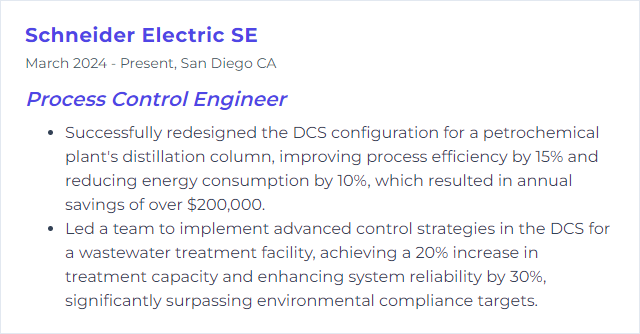
4. PID Tuning
PID tuning tunes the knobs—proportional, integral, derivative—so the process moves swiftly to setpoint without overshoot, noise-chasing, or oscillation.
Why It's Important
Tight loops slash variability, stabilize quality, and trim energy. Sloppy tuning costs scrap and headaches.
How to Improve PID Tuning Skills
Know the dynamics first: gain, lag, dead time. Start simple—bias, P-only to find the edge, then bring in I to kill offset and D to tame fast disturbances. Use methods like IMC/lambda tuning for dead-time-dominant loops and be cautious with Ziegler–Nichols in production. Add filters for noisy PVs and anti-windup for slow actuators. Ensure bumpless transfer between manual and auto. Trend, test small steps, and retune when the plant changes. For multivariable or constrained processes, consider model-based control.
How to Display PID Tuning Skills on Your Resume

5. HMI Development
HMI development crafts the operator’s window into the plant—layouts, navigation, status cues, and controls that keep cognition clear and response swift.
Why It's Important
Good HMIs cut through alarm floods and visual clutter. Operators spot trouble early, act quickly, and avoid mis-steps.
How to Improve HMI Development Skills
Adopt High Performance HMI principles (ISA-101): restrained color, strong contrast, clear hierarchy, and trend-at-a-glance. Keep navigation consistent; group by function or area, not by tag lists. Show states and limits clearly; highlight abnormal conditions without shouting. Standardize symbols aligned with ISA-5.1. Design for accessibility and varied lighting. Optimize update rates to avoid lag. Validate with real operators, iterate fast, and align alarms with your philosophy (ISA 18.2) so the screen and horn tell one story.
How to Display HMI Development Skills on Your Resume
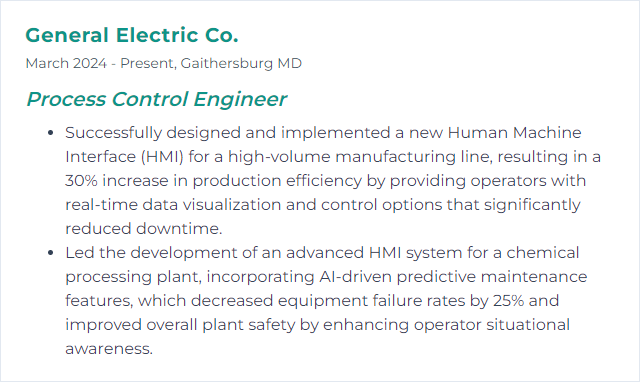
6. Six Sigma
Six Sigma shrinks variation and hunts defects using data, discipline, and the DMAIC cycle. The math matters, but so does practical change on the line.
Why It's Important
Less variability, higher yield, fewer surprises. It turns tribal hunches into measurable improvements that stick.
How to Improve Six Sigma Skills
Sharpen statistics: MSA, SPC charts, capability (Cpk/Ppk), regression, DOE. Pair these with process knowledge—constraints, physics, and failure modes. Build clear problem statements and operational definitions. Automate data collection where possible and visualize results cleanly. Use DOE to learn fast with minimal runs. Tie cost savings to metrics stakeholders care about. Blend tools from Lean to remove waste, and from modern analytics (MATLAB, Python) when patterns hide.
How to Display Six Sigma Skills on Your Resume
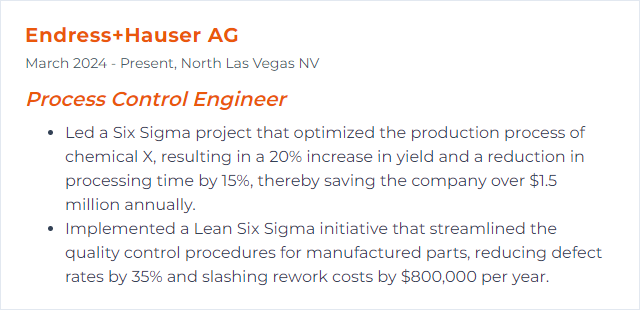
7. MATLAB/Simulink
MATLAB/Simulink provides a laboratory for models: identify dynamics, test controllers, simulate failures, and iterate in hours, not outages.
Why It's Important
It lowers risk. You can probe limits, compare strategies, and carry tuned parameters into the plant with confidence.
How to Improve MATLAB/Simulink Skills
Master fundamentals: scripts, functions, plotting, data handling. Explore Control System Toolbox, System Identification, and Simulink Control Design. Use Simscape to capture physical behavior. Validate models with plant data and keep parameter sets versioned. Apply model-based design for rapid iteration and auto-tuning. Practice with real scenarios: disturbance rejection, constraint handling, soft sensors. Document assumptions and keep models runnable for others.
How to Display MATLAB/Simulink Skills on Your Resume

8. AutoCAD
AutoCAD is the drafting workhorse for control system layouts, panels, and plant schematics. For P&IDs, AutoCAD Plant 3D’s P&ID features are the modern path.
Why It's Important
Clear drawings communicate intent, speed reviews, and prevent construction rework. Good standards save hours, again and again.
How to Improve AutoCAD Skills
Use Plant 3D for P&IDs and data consistency; manage symbols per ISA-5.1. Build dynamic blocks and parametric constraints for valves, instruments, and panels. Lean on xrefs, layers, and sheet sets for large projects. Create CAD standards (templates, plot styles, naming) and enforce them. Extract data (line lists, instrument indexes) directly from drawings to cut manual errors. For electrical integration, learn AutoCAD Electrical and align device tags between mechanical, electrical, and controls. Automate repetitive tasks with scripts or APIs when you do them twice.
How to Display AutoCAD Skills on Your Resume
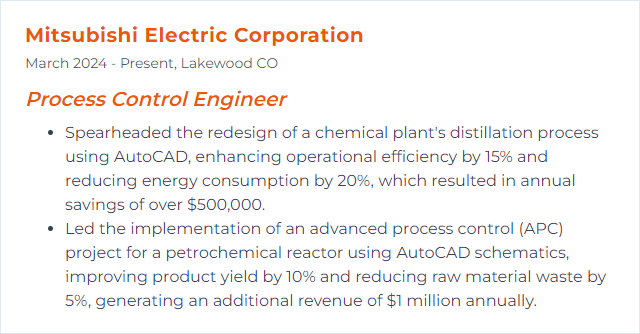
9. Industrial Networking
Industrial networking connects field devices, controllers, HMIs, historians, and enterprise systems under harsh conditions—reliably, deterministically, and securely.
Why It's Important
No network, no visibility. No visibility, no control. Performance and security live here.
How to Improve Industrial Networking Skills
Design with the Purdue Model in mind: segmented layers, a secure DMZ between OT and IT. Use VLANs, ACLs, and industrial firewalls to confine risk. Build redundancy (rings, PRP/HSR where needed) and monitor health. Time-synchronize with NTP or IEEE 1588 PTP for sequence-of-events. Choose the right protocol for the job—PROFINET, EtherNet/IP, Modbus TCP, OPC UA—and document addressing and naming. Harden switches and devices (disable unused services, unique passwords). Track assets and firmware; patch on a schedule. For wireless, lean on ISA100 or WirelessHART with careful site surveys. Train teams on incident response and practice it.
How to Display Industrial Networking Skills on Your Resume
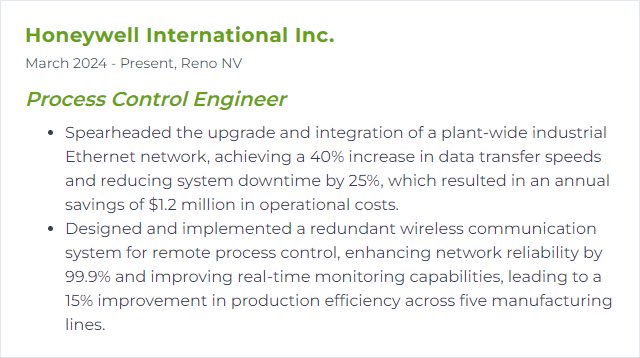
10. ISA Standards
ISA standards set shared rules of the road for automation: symbols, alarms, safety, cybersecurity, integration, and HMI design that teams can rally around.
Why It's Important
Standards keep systems interoperable, safe, and maintainable. They reduce surprises at handover and during audits.
How to Improve ISA Standards Skills
Get fluent in the big ones: ISA-5.1 (instrumentation symbols), ISA-18.2 (alarm management), ISA-84/IEC 61511 (SIS), ISA-95 (enterprise integration), ISA/IEC 62443 (cybersecurity), ISA-101 (HMI). Build project templates and checklists aligned to these. Run periodic compliance reviews and close gaps. Share internal guidance notes so new engineers climb fast. Participate in peer reviews; debate improves interpretations. Keep a changelog when standards update and brief stakeholders.
How to Display ISA Standards Skills on Your Resume
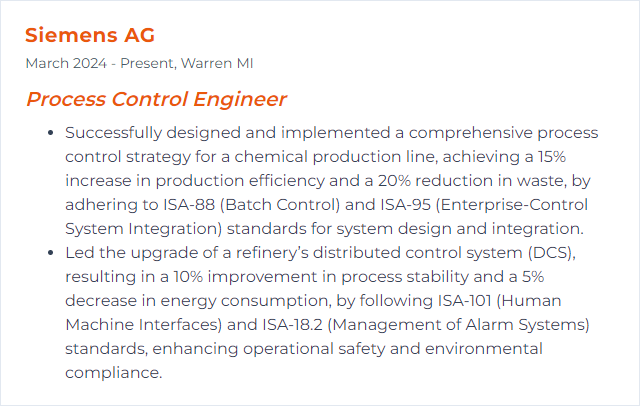
11. Safety Instrumented Systems
Safety Instrumented Systems (SIS) implement Safety Instrumented Functions (SIFs) that drive a process to a safe state when hazards loom—independent, decisive, and documented.
Why It's Important
They guard life, environment, and assets. When prevention fails, SIS limits consequences.
How to Improve Safety Instrumented Systems Skills
Start with rigorous hazard analysis (HAZOP) and risk assessment (LOPA) to set target SILs. Follow IEC 61511 across the full lifecycle: specification, design, verification, validation, operation, and decommissioning. Enforce independence from BPCS where required; avoid common-cause failures via diversity and segregation. Define proof test intervals and procedures; capture as-left data to refine PFDavg. Manage overrides and bypasses tightly. Keep a living Safety Requirements Specification (SRS). Train operators on trip causes and recovery. Audit performance, investigate demands, and feed lessons back into the lifecycle.
How to Display Safety Instrumented Systems Skills on Your Resume
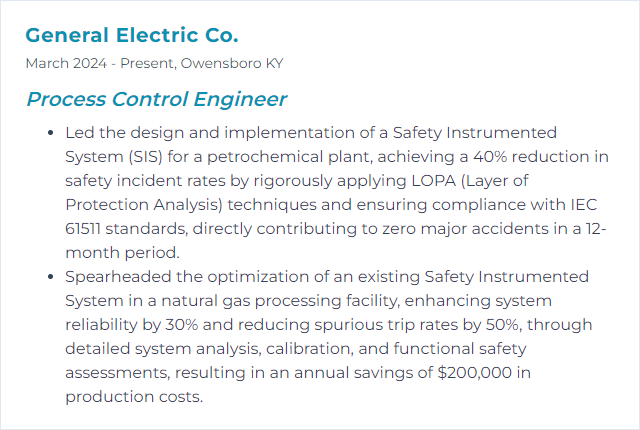
12. Process Simulation
Process simulation mirrors plant behavior with math and models—steady-state for sizing and balances, dynamic for startups, trips, and control testing.
Why It's Important
It de-risks change. You can test ideas without touching production, then bring only the good ones to the floor.
How to Improve Process Simulation Skills
Pick the right toolset for your process (e.g., dynamic simulation in Aspen HYSYS/Plus, gPROMS, or similar). Choose property packages carefully and validate against plant data; recalibrate as conditions evolve. Build models that are simple but honest—capture dominant dynamics and constraints. Co-simulate controls when needed and use hardware-in-the-loop for critical logic. Integrate live data for digital twins and real-time optimization if the business case supports it. Document assumptions, boundary conditions, and validation checks so others can trust and reproduce results.
How to Display Process Simulation Skills on Your Resume
